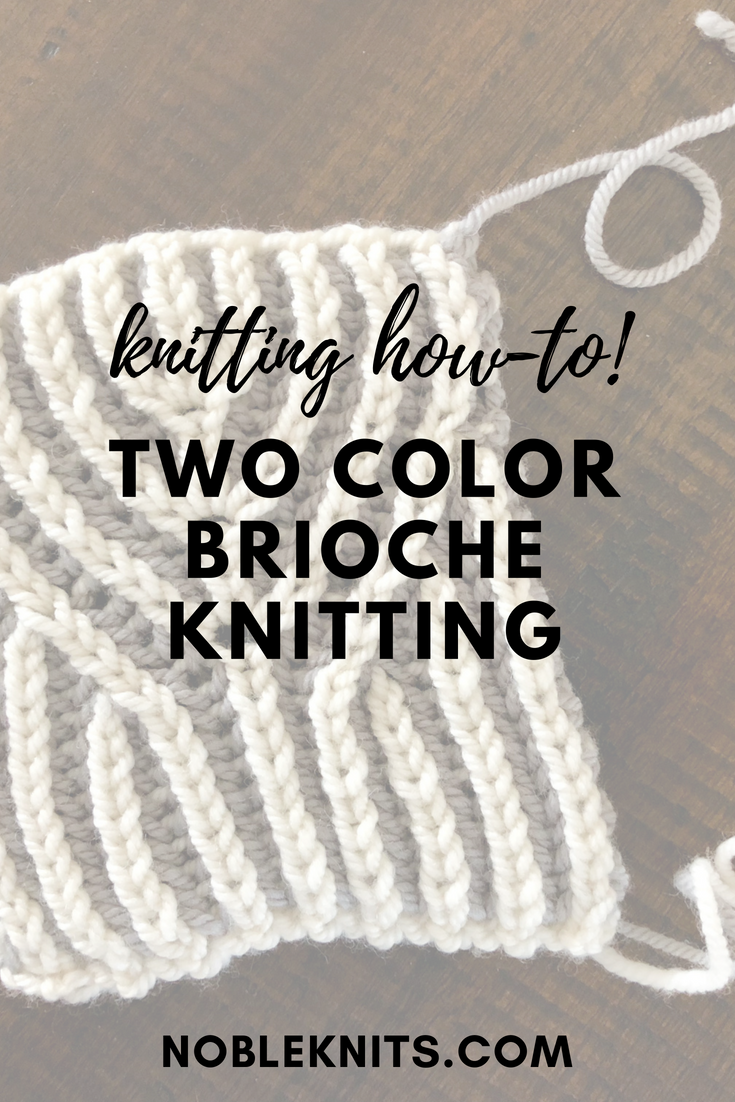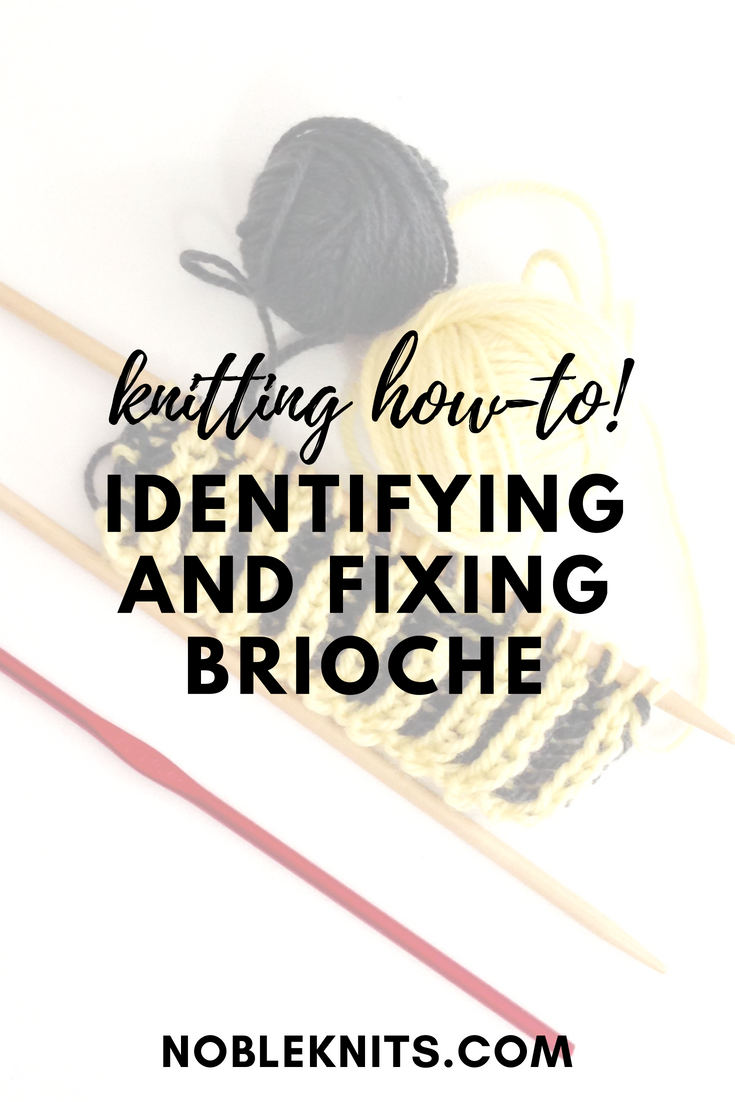Brioche Week, Day 2: 2-color brioche worked flat
Soooo... inquiring minds want to know! What did you think of yesterdays post and 1-color brioche?
Ok, so technically its just MY mind that wants to know. But I do, really, want to know. Did you find it hard? A breeze? Are you excited to step up your game? I sure hope so 'cuz here's where your mind gets blown... well, maybe not, but for reals, today the fun really begins!
2-COLOR BRIOCHE: WHAT'S THE SAME AS 1-COLOR?
It's safe to say that both of the stitches you learned yesterday (brk and sl1yo) are used. Beyond that, not a whole lot applies. Before we go jumping in to what's different, let's start with the abbreviation(s), and how they're the same (but different).
BRP - brioche purl!
In yesterday's blog post we talked about the BRK (brioche knit) stitch and the sl1yo (slip 1, yarnover) stitch. I suspect if you absorbed brk, you'll have absolutely no trouble with brp.
The BRP is worked very similarly to a p2tog - you will purl a stitch together with it's yo wrap.
sl1yo - read as "slip 1, yarnover".
The sl1yo doesn't really change between knits and purls. The same principles from yesterdays post will apply. However! The position of the working yarn does! Because purl stitches are already created with the working yarn in the front of the project, we don't need to move the yarn to begin the sl1yo stitch. However! Once we have slipped the stitch, we will need to bring the working yarn over the top of the RH needle and return it to the front between the needles, ready to purl the next stitch. The "yo" part of the sl1yo is very obvious on a brp row of sl1yo's.
Slide
The act of "sliding" in brioche is used ONLY in 2-color brioche worked flat. Each side of the fabric (the RS and WS) need to be worked 2 times: once with Color A and once with Color B. In order to work both colors on the RS in succession, once we work across a row using Color A, instead of TURNING the work, we SLIDE all of our stitches back along the needle so that the working yarn of Color B is on the right edge, ready to be worked.
Turn.
I'm pretty sure you've got this one figured out... "Turn" simply means that we now have to turn the work to the opposite side facing and work across with Colors A and B.
Note that different designers will specify the rows using various notations. For example, when I write a 2-color brioche project I have Rows 1a and 1b - all "a" rows are worked with Color A and all "b" rows are worked with Color B. Some designers designate using MS (main side) and MC (main color) and CS (counter side) and CC (counter color). Neither is more right or wrong, just different language. In the "knit along with me" portion below you'll see how this is put into use.
The last similarity between 1-color and 2-color brioche worked flat is that we will work a setup row (thought this is true of ALL brioche work). Beyond that, it's a whole new ball game! Let's dive in!
2-COLOR BRIOCHE: WHAT'S DIFFERENT?
2-color brioche, worked flat, with some shaping worked in.
2-color brioche worked flat is built rather differently than 1-color. In 1-color brioche worked flat the RS and WS are worked exactly the same and only use the brk1 and sl1yo sts.
However, in 2-color brioche, not only do we introduce the concept of brp's (brioche purl stitches) and sliding vs turning the work, but 2-color brioche is also worked 2 times per row. This means that 2 rows of completed brioche actually requires 4 rows of knitting to be worked.
Here's how the fabric is built. We will assume you've cast on with Color A and will be starting on a RS row.
Row 1a is the Setup row, is generally worked on the RS of the fabric and is also generally worked using the color you cast-on with; in this case, Color A.
Row 1a won't be repeated again, it is only worked once and will be a combination of alternating knit stitches (not brioche knit since none of your stitches are yet wrapped) and sl1yo's much like yesterday's Setup Row. Once you have worked across the row, do not turn your work. SLIDE all the sts to the right tip of the needle to be worked again (hence why we need DPNs or circulars, not a needle with a stopper).
Row 1b is also worked on the RS of the fabric but will be worked using color B. Additionally, this row will be worked using BRPs and sl1yo's. Once the row is complete, TURN your work.
Row 2a is the first row on the WS. It is worked using Color A and will be worked in BRPs. Once complete, SLIDE all the sts back to the right tip of the needle to be worked again.
Row 2b is also worked on the WS and is worked using Color B. This row returns us back to using BRK's. TURN your work at the end of the row.
I find this graphic helps explain it a little more clearly, visually, before we jump into the video. You'll note that while the colors (indicated by the arrows) alternate, the BRK and BRP rows mirror: Color A/Color B/Color A/Color B vs. BRK/BRP/BRP/BRK.
How to Work 2-Color Brioche, Flat
Alright, let's get to the business of seeing how this is put together! I've used two colors of high contrast yarn to show how the stitches relate to one another.
In the following video, similar to yesterday, I used two colors of Ewe Ewe Yarns Ewe So Sporty (Lemon Chiffon and Charcoal, if you're curious) and 2 DPN needles in a size US 6 (4mm). Remember, the needles for today's work can't have stoppers!
SIDE NOTE: These videos that I'm sharing are over 3 yeras old and were the first videos I created. The text that I am sharing with you below is more accurate than the video. In the video I say "Row 1, Row 2, Row 3 and Row 4" but you're better off referencing the structure below. Just to keep you on track: Row 1 = Setup Row 1a, Row 2 = Setup Row 1b, Row 3 = Row 2a and Row 4 = Row 2b.
LET'S KNIT ALONG WITH THE VIDEO!
Cast on 20 sts using Color A. All "a" rows are worked with Color A and all "b" rows are worked with Color B.
Setup Row 1a (RS): K1, *k1, sl1yo; rep from * to last st, k1. SLIDE.
Setup Row 1b (RS): K1, sl1yo, *brp1, sl1yo; rep from * to last 2 sts, brp1, k1. TURN.
Row 2a (WS): K1, sl1yo, *brp, sl1yo; rep from * to last 2 sts, brp1, k1. SLIDE.
Row 2a (WS): K1, *brk1, sl1yo; rep from * to last st, k1. TURN.
*** The per row video instruction ends here - the remaining 4 rows I work off camera are worked thus:
Row 3a (RS): K1, *brk1, sk1yo; rep from * to last st, k1. SLIDE.
Row 3b (RS): K1, sl1yo, *brp1, sl1yo; rep from * to last 2 sts, brp1, k1. TURN.
Row 4a (WS): K1, sl1yo, *brp1, sl1yo; rep from * to last 2 sts, brp1, k1. SLIDE.
Row 4b (WS): K1, *brk1, sk1yo; rep from * to last st, k1. TURN.
Rep [Rows 3-4, a & b] until the fabric is as long as you like, ending with Row 4b.
A TIP ON TRACKING SLIDES VS TURNS!
It's happened! You were happily knitting along on your 2-color brioche, worked flat, and you got called away. You jumped up, dropped your knitting, and handled whatever called you away (something that probably wasn't NEARLY as important as your brioche, amiright?!)
How do you tell whether you need to TURN or SLIDE the work?
I use my working yarns as an indicator! If Color A and Color B yarns are TOGETHER at the end of a row, you need to TURN your work and work the other side. Get it? 'T' for together, 'T' for turn?
Concurrently, if the yarns are SEPARATED (i.e.: Color A is at one end of the work and Color B is at the other end) you need to SLIDE. 'S' for separated, 'S' for slide.
More Brioche Tomorrow!
Tomorrow we're going to tackle the awesomeness that is 1-color brioche in the round. I'm happy to knit brioche any which way it comes at me but my favorite is in the round. There's a delightful rhythm that goes along with brioche in the round and I hope you'll love it as much as I do!
Feel free to ask questions here in the blog post. And if you're a social media user, we would love to see the samples of you trying out brioche. Tag @nobleknits on Twitter or Instagram and use #briocheweek on Twitter, Instagram or Facebook.









